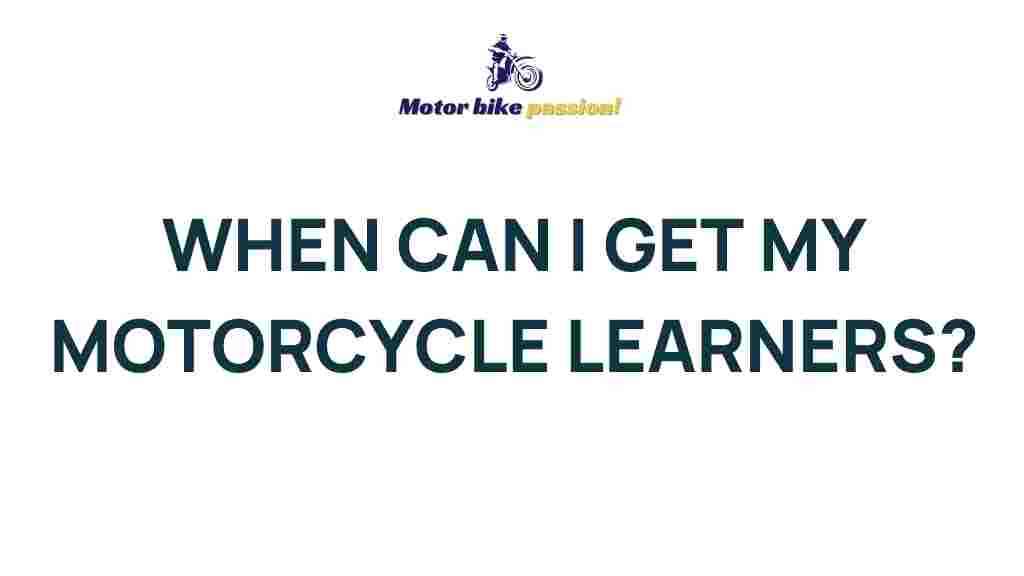Unveiling the Mystery: When Can You Obtain Your Motorcycle Learner’s Permit?
Are you eager to hit the open road on two wheels? Obtaining a motorcycle learner’s permit is the first step towards your adventure. In this comprehensive guide, we’ll explore the requirements, eligibility, and the application process for getting your motorcycle learner’s permit. Additionally, we will discuss the restrictions that come with it, so you can ride legally and safely. Let’s dive in!
Understanding the Motorcycle Learner’s Permit
A motorcycle learner’s permit is an essential document that allows new riders to practice operating a motorcycle under specific conditions. This permit is typically issued by the Department of Motor Vehicles (DMV) or equivalent authority in your state or country. It serves as a stepping stone to obtaining a full motorcycle license.
Eligibility Requirements for a Motorcycle Learner’s Permit
Before you can apply for a motorcycle learner’s permit, you must meet certain eligibility criteria. Here’s what you need to know:
- Age: Most states require you to be at least 16 years old, but some may allow younger applicants with parental consent.
- Driver’s License: You may need to hold a valid driver’s license or a learner’s permit for other vehicles.
- Knowledge Test: Be prepared to pass a written knowledge test that covers motorcycle safety and road rules.
- Vision Test: A vision exam may also be required to ensure you can see adequately while riding.
Step-by-Step Application Process
Now that you understand the eligibility requirements, let’s go through the application process for obtaining your motorcycle learner’s permit.
Step 1: Research Local Requirements
Before you start your application, check your local DMV website or contact them directly to understand specific requirements in your state. Each state may have different rules regarding fees, documentation, and testing.
Step 2: Gather Necessary Documents
Typically, you will need the following documents:
- Proof of identity (such as a birth certificate or passport).
- Proof of residency (like a utility bill or bank statement).
- Your existing driver’s license or learner’s permit.
- Any required application forms that you can usually download from the DMV website.
Step 3: Complete the Application Form
Fill out the motorcycle learner’s permit application form accurately. Ensure all information is correct to avoid delays in processing.
Step 4: Schedule and Take the Knowledge Test
After submitting your application, you may need to schedule a time to take the knowledge test. This test will assess your understanding of motorcycle operation and safety rules.
Step 5: Pass the Vision Exam
Most states also require a vision test. Ensure you meet the minimum vision requirements to operate a motorcycle safely.
Step 6: Pay the Required Fees
There will typically be a fee associated with obtaining your motorcycle learner’s permit. Make sure to check the exact amount and payment methods accepted.
Step 7: Receive Your Motorcycle Learner’s Permit
Once you’ve completed all the necessary steps, you will receive your motorcycle learner’s permit. This document allows you to practice riding under certain restrictions.
Restrictions of a Motorcycle Learner’s Permit
As a learner, there are specific restrictions you must follow while riding with your motorcycle learner’s permit:
- You may be required to wear a helmet at all times.
- You might be restricted from riding at night or carrying passengers.
- Some states require you to ride only during daylight hours.
- You cannot ride without a licensed motorcyclist accompanying you in some jurisdictions.
Tips for Success While Holding a Learner’s Permit
Here are some tips to help you make the most of your time with your motorcycle learner’s permit:
- Practice Regularly: The more you practice, the more comfortable you’ll become. Try to ride in different conditions and environments.
- Take a Safety Course: Enrolling in a motorcycle safety course can provide invaluable skills and knowledge, often leading to insurance discounts and sometimes waiving the road test requirement for a full license.
- Stay Informed: Always keep up to date with local laws and changes regarding motorcycle riding.
- Ride with Experienced Riders: If possible, ride with friends or family who have experience. They can offer guidance and support.
Troubleshooting Common Issues
While applying for and holding your motorcycle learner’s permit, you may encounter some common issues. Here are some solutions:
Issue 1: Failing the Knowledge Test
If you don’t pass the knowledge test, don’t be discouraged. Review your study materials and retake the test at a later date. Many DMVs provide resources to help you prepare.
Issue 2: Missing Documents
Always double-check that you have all necessary documents before your appointment. If you forget something, you may need to reschedule, causing delays in getting your permit.
Issue 3: Unfamiliarity with Riding
If you feel nervous about riding, consider taking a basic rider course. This can help build your confidence and skills before you venture out on your own.
Conclusion
Obtaining your motorcycle learner’s permit is a thrilling first step towards becoming a skilled rider. By understanding the requirements, eligibility, and the application process, you’ll be well-prepared to navigate the world of motorcycling. Remember to abide by the restrictions that come with the permit, practice regularly, and take advantage of resources available to new riders.
Are you ready to embark on your motorcycle journey? For more information, check out your local DMV’s website here. And don’t forget, safety comes first—so equip yourself with knowledge and riding skills before hitting the road!
For additional resources and tips on motorcycle riding, visit this helpful guide.
This article is in the category Basic Guides and created by MotorBikePassion Team

1 thought on “Unveiling the Mystery: When Can You Obtain Your Motorcycle Learner’s Permit?”